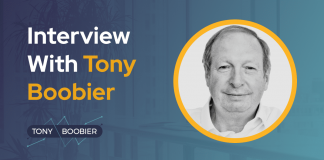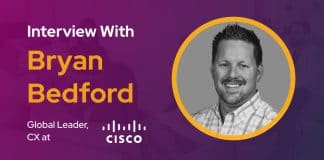Hi Adrian, tell us about yourself and how you got to the CX space.
I trained and worked as an economist, then as a teacher, working in the UK and overseas. Then I decided not to go down that route, got an MBA, transitioned into the commercial world, and worked for a couple of big corporations until 2004. Then I went independent, and around 2008, I realized that if I wanted to do that, I needed to build a reputation in a particular area. Because I could foresee the way that the market was developing, that required me to build a digital presence. So people could get to know me at a distance.
I started my own website, adrianswinscoe.com, and started writing about general stuff, but that got boring and dry very quickly. So I thought I needed to start writing about something that I wanted to change. I figured out that I didn’t like bad service. It frustrates me that organizations often get in the way of their people doing a good job. I started writing and researching about that topic.
I’m not advocating for a way to do things. I see myself as being an explorer; I explore in public about what we could do, and how we could do it. That gives me a very open canvas to think about what we can do differently.
In 2013, I was approached by Forbes. They liked what I was doing and they asked if I could write a column for them, which was a privilege for me. I wrote a book in 2016, and it reached number one in its category on Amazon, which I’m very proud of. I then self-published another book titled Punk CX. It was born out of a frustration with what was going on in the experience space. It’s a very different book, full of color, very short, very pithy, very to the point, inspired by punk music. I call it a visual slap in the face for the CX industry. And so that’s how I got into this space that is now called customer experience.
At the time, it wasn’t really called customer experience. I’m more interested in service, and what we do to deliver better service and give ourselves a good chance of a customer having a good experience with us. I feel very grateful that people pay attention. They like some of the things that I think about and say. In short, I get paid to do stuff I like with people I like, really.
As the online channel skyrocketed in 2020, how important have consumer insights been in decision making?
When people talk about insights, they tend to talk about surveys and feedback scores. But in reality, the best insights are a combination of that with the data that’s not formally given in a survey — how a customer is interacting with you. When you can combine that active feedback with the operational data, that’s when you get a rich dataset.
Because things changed so quickly in 2020, consumer insights played an important part, but I think what happened has forced companies to listen, and also change as quickly. There was this collapse of the gap between the rhetoric of “our customers are really important to us, they’re the center of our business” and the actual activity. People have been forced to see beyond the numbers and to look for the real insights.
Many customers have bemoaned or said that they would like to have seen more empathy in the interactions that they had with businesses. Because they’re used to being dealt with on a transactional basis… But I’m not just a wallet. I’m a real person. And that’s been a big challenge for many organizations. This has pushed many to really rethink how they go about doing things, how they understand their customers, and how they respond to some of their concerns. Everybody’s latching on to the concept of numbers, the metrics, and there’s this almost a cult of NPS: Is it going up? Is it going down? That’s fine, but it’s just a number, it doesn’t necessarily tell you much other than the number. It should be combined with the qualitative data.
It’s not about how much insight you’ve got, but more about how good it is and what you do with it.
Adrian’s predictions for the future of CX
What is 2021 going to look like, in your opinion?
I think we will see a continuation and maturation of this whole process. People are trying to have a faster turnaround with a richer set of insights — combining feedback from customers with other types of research and connections, as well as their operational data — to try to take some of the guesswork out of it.
This is part of the new way of doing things. And that is the challenge: maintaining that pace of change, the drive and the commitment to do better. Get close to your customers, deliver things that matter, change things that don’t work, do it quickly, and just keep going. It’s tiring and it’ll take time for us to get used to it, but that’s the imperative right now.
How do you apply customer experience benchmarks in your day-to-day?
I don’t. I find that the idea of benchmarks is sometimes like a fast track to average, because I feel that benchmarks are about paying attention to how you’re doing relatively to other people. It’s a bit like a sprint race — if you’re always focusing on the results of your competitors, that’s fair enough, but maybe you should be focusing more on your own performance.
My personal measure is that I do what I do. I don’t care about anyone else. The people that I work with continue to want to work with me. People keep showing up and knocking on my door, or sending me an email, or giving me a call and asking: “Can you help me?”
How much has customer experience management changed in the social distancing era? What role does digital transformation have in this crisis?
I don’t like the term “digital transformation,” because for me there’s a part of it that implies that once you transform, then you’re done. It’s never going to be done; that’s the illusion behind it. It’s more likely to be an evolutionary cycle. Has that accelerated? Absolutely, out of necessity. I understand what we mean by the term, but it gets so overused. It almost becomes meaningless, everyone wants to be part of the club. You pay your ticket, you get inside… And then you realize everybody’s talking about different things.
The digital side of things will be different for each business. If I’m a manufacturer of machinery for the agricultural industry, and a large part of my business is about going out and visiting farmers, then the digital element of my business is very different from that of a fashion retailer.
Some of these big terms can sometimes feel reductive, and it gets to the point where people talk about it and it ends up making no sense. We still talk about it as if it were a different way of doing business, but it’s just business. The idea that there’s either “digital” or “not digital” is not true anymore. Everything is fused together.
I get frustrated about the fact that many organizations get in the way of their employees doing a good job. Employee experience is about the culture, the onboarding, the career, and talent development, but it’s also about the operational level: What are we doing to help our people design, deliver, and develop great experiences for our customers? As customers, we want things to be seamless. If I call you and I’m a customer of yours, I want you to know who I am. I also want you to know that I’ve called you before, and I’ve bought X and Y things in the past. Step up, do the work!
What was the biggest lesson you learned in 2020?
I would say that a lot of people were surprised about what they were capable of doing and how quickly some things could get done. Things started happening in weeks and days, rather than months and years. That’s the biggest lesson: that we can achieve – and many companies have achieved – way more than we thought was possible.
2020 was the year of webinars and online events. What was your favorite one?
I don’t have a favorite. I did quite a lot of them. I always try to make them different, depending on who they were with. So there’s no real standout one.
It’s always nice to try and do different things, explore different ideas, delivery styles, formats, and try and make it fun and engaging; not just another boring, monotonic sort of drab fest. I did do one, which I thought was quite cool and tried to do it a couple of times. Rather than just having a conversation and presenting slides as it were, I had a printout of slides that I used to show, which I thought was just old school in many ways. And that was quite fun. Because you’re actually talking to people, having a conversation.
Any you’ve attended that you liked?
I normally go to PegaWorld iNspire, an in-person event by Pegasystems that takes place every year in Vegas. Last year, they took the whole event and tried to cram it into two and a half hours, and the MC for the event was their CTO, Don Shuerman. You see him speaking and then he gets transformed into a little avatar. He would bounce around, on the show, around the agenda, on the screen, as this little avatar walking about. That was really good. Nice, and kind of quirky; I’d not seen it done like that before.
It looks like working from home is going to stay with us for the foreseeable future. How should CX executives gear up to the changing times?
They should start by freeing up their time! One of the things we’ve noticed is that if people are working for a brand, they’re busy, having meeting after meeting after meeting, getting longer days, running late, all that sort of stuff. And the question has got to be, at what point do you do some actual work? Many execs say that they want to be saying yes to all these meetings, to be involved. It’s almost a fear of missing out.
I think leaders need to create the space in their schedules to identify problems, to spend more time looking at the data, or talking to customers, or talking to their employees — so that they can start to formulate plans of how to solve these problems. You can’t do that if you’re in meetings all day.
I would challenge people to try and cancel 20-30% of all the meetings that they get invited to on a weekly basis. In fact, you can have some fun with that. Start canceling meetings to the point when people start to notice!
It’s an old saying, but time is the only thing that we can’t get any more of. And if people, and particularly leaders, don’t start managing their time better, then time gets managed for them. As a leader, you’ve also got to think about your role more broadly: How can I step back and work on things, so that I can think about the improvement of the situation for everybody?
Carve out some space and time to do that.






